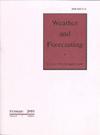利用基于目标的度量评估热带气旋降水实验高分辨率模式预报
IF 3.1
3区 地球科学
Q2 METEOROLOGY & ATMOSPHERIC SCIENCES
引用次数: 0
摘要
热带气旋(TC)的降水造成了包括淡水泛滥在内的严重危害。高分辨率飓风模型预测TC降雨的位置和强度,这可能会影响当地的疏散和准备政策。本研究评估了两个实验模型,即飓风分析和预报系统(HAFS)模型和盆地级飓风天气研究和预报(HWRF-B)模型对2020年北大西洋登陆TC的0-72小时降水量预测。我们使用一种基于对象的方法来量化预测和观测到的降水量的形状和大小。然后使用空间度量(例如,面积、周长、延伸率)比较降水对象的轻度、中度和重度降水。结果表明,这两个模型都预测了过于连接、过于靠近TC中心、过于包围TC中心的降水量。总的来说,这些空间偏差表明,即使两个模型都存在负强度偏差,模型预测也过于强烈,这表明降水配置和模型预测中的最大持续风之间可能存在不一致。HAFS模型难以预测层状降水与对流降水的关系,也难以表示初始化后前六小时的较轻(层状)降水。HWRF-B预测中没有出现这种旋转问题,相反,它在所有交付周期都表现出系统性偏差,在所有降雨率阈值上都表现出了系统性问题。未来的工作将研究HAFS模型预测中的旋转问题,以及微物理参数化如何影响两个模型中降水的表现。本文章由计算机程序翻译,如有差异,请以英文原文为准。
Evaluation of Experimental High-Resolution Model Forecasts of Tropical Cyclone Precipitation using Object-Based Metrics
Tropical cyclone (TC) precipitation poses serious hazards including freshwater flooding. High-resolution hurricane models predict the location and intensity of TC rainfall, which can influence local evacuation and preparedness policies. This study evaluates 0–72-hour precipitation forecasts from two experimental models, the Hurricane Analysis and Forecast System (HAFS) model and the Basin-scale Hurricane Weather Research and Forecasting (HWRF-B) model, for 2020 North Atlantic landfalling TCs. We use an object-based method that quantifies the shape and size of the forecast and observed precipitation. Precipitation objects are then compared for light, moderate, and heavy precipitation using spatial metrics (e.g., area, perimeter, elongation). Results show that both models forecast precipitation that is too connected, too close to the TC center, too enclosed around the TC center. Collectively, these spatial biases suggest that the model forecasts are too intense even though there is a negative intensity bias for both models, indicating there may be an inconsistency between the precipitation configuration and the maximum sustained winds in the model forecasts. The HAFS model struggles with forecasting stratiform versus convective precipitation and with the representation of lighter (stratiform) precipitation during the first six hours after initialization. No such spin-up issues are seen in the HWRF-B forecasts, which instead exhibit systematic biases at all lead times and systematic issues across all rain rate thresholds. Future work will investigate spin-up issues in the HAFS model forecast and how the microphysics parameterization affects the representation of precipitation in both models.
求助全文
通过发布文献求助,成功后即可免费获取论文全文。
去求助
来源期刊

Weather and Forecasting
地学-气象与大气科学
CiteScore
5.20
自引率
17.20%
发文量
131
审稿时长
6-12 weeks
期刊介绍:
Weather and Forecasting (WAF) (ISSN: 0882-8156; eISSN: 1520-0434) publishes research that is relevant to operational forecasting. This includes papers on significant weather events, forecasting techniques, forecast verification, model parameterizations, data assimilation, model ensembles, statistical postprocessing techniques, the transfer of research results to the forecasting community, and the societal use and value of forecasts. The scope of WAF includes research relevant to forecast lead times ranging from short-term “nowcasts” through seasonal time scales out to approximately two years.
 求助内容:
求助内容: 应助结果提醒方式:
应助结果提醒方式:


